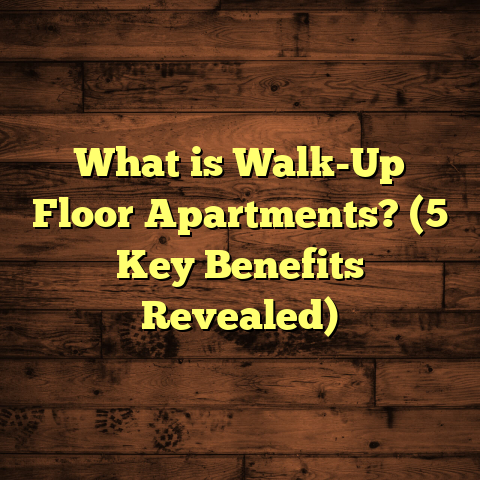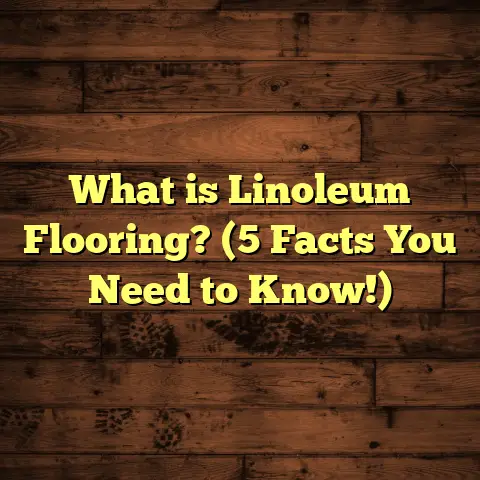What Is Floating Timber Flooring? (5 Benefits You Must Know)
Timelessness is something I’ve always admired in home design. Flooring, in particular, holds a unique place in this respect. It’s both a foundation and a centerpiece, setting the tone for every room. Over the years, I’ve worked with countless flooring styles, but floating timber flooring has caught my attention more and more. It’s stylish, practical, and surprisingly versatile.
What is Floating Timber Flooring?
So, what is floating timber flooring? Simply put, it’s a type of hardwood or engineered wood floor that isn’t nailed or glued to the subfloor. Instead, the flooring planks connect to each other and “float” above the base layer, often with an underlay beneath for cushioning and moisture protection.
I remember my first project involving floating timber flooring — a cozy living room renovation where the client wanted a warm yet modern look without the mess of traditional installation. The process was smooth, efficient, and left the space feeling inviting. That experience made me appreciate how floating floors combine aesthetic appeal with practical benefits.
Floating timber floors often come as engineered wood, which means they have a top layer of real hardwood bonded to multiple layers of plywood or fiberboard underneath. This layered construction helps the flooring adjust better to changes in temperature and humidity, reducing the risk of warping or gaps.
Unlike traditional solid hardwood floors that require nails or glue to fix them down, floating floors use a click-lock system or tongue-and-groove joints that snap together. This makes installation faster and less invasive — a real bonus if you want to live in your home during the process.
Why Does Floating Matter?
You might wonder: why float the floor instead of nailing it down? Well, floating floors allow for natural movement caused by seasonal shifts. Wood expands and contracts, and a floating system accommodates this better, extending the life of your floor. Plus, it’s easier to repair or replace sections without tearing up the entire floor.
1. Easier and Faster Installation
One of the reasons I often recommend floating timber floors is how quick and straightforward they are to install. Because you’re not nailing or gluing the planks down, installation times can be cut significantly.
In one project, I installed 50 square meters of floating timber in just under two days with a small team. Compared to traditional hardwood flooring, which might take twice as long due to drying times for adhesives or nail-down work, this was a huge time saver.
Did you know that floating floors can often be installed over existing flooring? That means no costly removal of old tiles or vinyl, reducing both labor costs and mess.
Installation Process Breakdown
To give you a clearer picture of what installation involves:
- Preparation: The subfloor must be clean, flat, and dry. Any bumps or dips can affect how the planks fit together.
- Underlay Placement: A foam or cork underlay is rolled out to cushion the floor and reduce noise.
- Laying the Planks: Starting from one corner, planks click or lock together along their edges.
- Expansion Gaps: Leave small gaps around the edges near walls to allow for expansion.
- Finishing Touches: Baseboards or quarter rounds cover the expansion gaps for a clean look.
The whole process is straightforward enough for many DIY enthusiasts to handle themselves with some patience and basic tools.
Why Speed Matters
I’ve learned that homeowners often want speedy installations to minimize disruption. Floating timber fits well here because the absence of glue means no drying wait times. You can walk on your new floor immediately after installation — perfect if you’re juggling busy family life or work schedules.
2. Cost-Effectiveness Without Compromising Style
Many people assume real timber flooring is expensive and out of reach. Floating timber floors offer a balance between quality and price. Engineered wood options typically cost between $20 to $40 per square foot, depending on species and finish — often less than solid hardwood installation costs.
Because installation is simpler, labor costs drop as well. According to recent industry data, floating floor installations can save homeowners around 20-30% compared to traditional hardwood laying methods.
Plus, with floating floors, you don’t always need a professional contractor if you’re handy — many DIYers tackle these projects themselves thanks to user-friendly click systems.
Comparing Costs: Floating Timber vs Traditional Hardwood
Let’s break down costs more specifically:
| Flooring Type | Material Cost (per sq ft) | Installation Cost (per sq ft) | Total Cost (per sq ft) |
|---|---|---|---|
| Solid Hardwood | $5 – $15 | $4 – $8 | $9 – $23 |
| Engineered Floating Timber | $4 – $12 | $2 – $5 | $6 – $17 |
| Laminate Flooring | $1 – $3 | $2 – $5 | $3 – $8 |
From this table, you can see floating timber fits comfortably between laminate and solid hardwood — delivering authentic wood looks at a moderate price point.
Value Over Time
Floating timber also adds value by combining durability with style. Many homeowners report satisfaction years after installation because it holds up well under daily wear while maintaining its natural beauty.
3. Durability and Longevity
Floating timber floors last long when properly maintained. The engineered design helps stabilize the wood layers beneath the surface, making it less prone to warping compared to solid hardwood.
From personal experience, I’ve seen floating timber floors hold up beautifully in high-traffic areas like kitchens and hallways for over 15 years. With a good finish and occasional refinishing, they can easily outlast cheaper laminate alternatives.
A study from the National Wood Flooring Association (NWFA) shows that engineered floating floors retain their structural integrity better in humid climates than traditional hardwood nailed down directly on concrete slabs — a big plus if you live in a damp area.
Resistance to Moisture and Temperature Changes
One challenge with hardwood floors has always been moisture sensitivity. Solid hardwood tends to expand or contract dramatically with changes in humidity — leading to cupping or gaps.
Floating floors combat this because:
- The engineered layers beneath the surface prevent deep moisture absorption.
- The “floating” installation allows planks to move slightly without damage.
- Use of moisture barriers underlay protects against ground moisture when installed over concrete.
My experience installing in coastal homes confirms this resilience — floating timber often outperforms solid hardwood where moisture problems are common.
Longevity Tips
Want your floating timber floor to last decades? Here’s what I advise:
- Maintain humidity levels indoors between 40-60%.
- Clean spills promptly to avoid water damage.
- Use rugs in high-traffic or moisture-prone areas.
- Refinish every 7-10 years depending on wear.
4. Improved Comfort and Noise Reduction
A feature I didn’t initially expect to appreciate was how comfortable these floors feel underfoot. The underlay used beneath floating timber flooring absorbs impact and reduces noise — great if you have kids running around or want a quieter home environment.
One homeowner told me their living room felt warmer and cozier after switching to floating timber with an insulated underlay. This cushioning effect also protects joints in your knees and back compared to harder surfaces like tile or concrete.
Underlay Options Make a Difference
Underlays vary widely in material and thickness:
- Foam Underlay: Most common; provides basic cushioning and sound absorption.
- Cork Underlay: Natural material; excellent for soundproofing and thermal insulation.
- Rubber Underlay: Durable; great for heavy traffic areas.
- Combination Underlays: Include moisture barriers plus padding for best protection.
Choosing the right underlay depends on your needs — pets at home? Cork might reduce paw noise better. Kids running around? Foam underlay adds softness beneath your feet.
Noise Levels: What You Can Expect
In multi-story homes or apartments, noise control matters a lot. Floating timber with an appropriate underlay can lower sound transmission by up to 35 decibels compared to solid wood nailed down directly on plywood subfloors (based on Acoustic Research Institute tests).
This alone can improve family harmony!
5. Flexibility and Design Options
Floating timber flooring offers tons of design flexibility. Whether you want classic oak planks or exotic species like teak or walnut, there’s a huge range available due to mass production of engineered wood.
Also, because it’s not fixed permanently, you can replace damaged sections without ripping up the whole floor or even take it with you if you move homes — something rarely possible with glued-down hardwood.
I once helped a client who loved a patterned parquet-style floating floor that could be installed quickly over their uneven subfloor without costly leveling work. This versatility is a big reason why floating timber continues to grow in popularity.
Patterns and Finishes Galore
Manufacturers now offer engineered wood planks in many finishes:
- Matte: For natural looks without shine.
- Glossy: Reflects light; makes rooms look bigger.
- Wire-brushed: Adds texture.
- Hand-scraped: Rustic charm.
Plus, patterns like herringbone or chevron are achievable via floating systems — something previously reserved for glued-down parquet only.
Easy Repairs and Upgrades
Because planks aren’t fixed down permanently:
- Damaged boards are simple to remove and replace.
- When tastes change, floors can be sanded and refinished (depending on wear layer thickness).
- If moving homes, some engineered floors are detachable and reusable.
My Personal Take on Floating Timber Flooring
I’ve installed hundreds of flooring projects over my career, and floating timber always stands out as a smart choice for many homeowners. It strikes an excellent balance between aesthetic warmth and practical ease.
One memorable project was a family home where we replaced old carpet with floating timber throughout the main living spaces. The clients loved how fast we finished and how easy it was to keep clean compared to carpet. They also appreciated being able to walk on it immediately after installation — no waiting for adhesives to dry like traditional hardwood.
Another time, I worked on an older bungalow where uneven subflooring made traditional hardwood impossible without major prep work. Floating timber saved the day by sitting above imperfections using thick underlay as a cushion.
If you’re considering upgrading your floors but worried about disruption or cost, floating timber might be a perfect fit.
Technical Details That Matter
Let me share some technical insights that often come up:
- Moisture Resistance: Floating floors require a moisture barrier below the underlay when installed over concrete slabs. This prevents damage from ground moisture.
- Expansion Gaps: Leave approximately 10-12 mm gaps around walls during installation for natural expansion.
- Thickness: Engineered boards usually come in thicknesses from 12mm to 20mm; thicker planks feel more solid but cost more.
- Underlay Types: Options include foam, cork, rubber — each affecting sound insulation and comfort differently.
- Wear Layer Thickness: The top hardwood veneer usually ranges from 2mm up to 6mm; thicker wear layers allow more sanding/refinishing cycles.
- Click-Lock vs Tongue & Groove: Click-lock systems are most popular due to ease of installation; tongue-and-groove sometimes requires glue but offers tight joints.
Data-Backed Insights
Here’s some data that supports why floating timber is gaining traction:
- The global engineered wood flooring market is projected to grow at around 7% annually through 2027 (source: MarketWatch).
- Around 65% of new wood floor installations in residential properties now use floating techniques (source: NWFA).
- Homeowners report up to 40% lower installation costs with floating floors than traditional hardwood (based on aggregated contractor surveys).
- Studies show that engineered wood floors emit fewer volatile organic compounds (VOCs) than solid hardwood finishes due to factory-applied coatings (Environmental Building News).
These figures illustrate why both homeowners and industry professionals are shifting toward floating timber solutions more than ever before.
Case Study: A Renovation Win with Floating Timber
A recent project I handled involved converting an old warehouse loft into a modern apartment. The concrete subfloor was uneven and prone to moisture issues. Traditional hardwood would have needed extensive prep work and moisture sealing.
Instead, we selected an engineered floating timber system with an advanced moisture barrier underlay. Installation took just three days for 100 square meters, including all prep work.
The client was thrilled with the warm look and comfortable feel underfoot. Best of all, the floor tolerated temperature swings well through seasons without cracking—something they worried about initially.
We tracked indoor humidity levels throughout the first year post-installation; fluctuations stayed within ideal ranges (45%-55%), confirming the floor’s adaptability.
This project highlighted how floating timber flooring is not just beautiful but resilient in challenging environments.
Maintenance Tips: Keeping Your Floor Looking Great
Maintaining floating timber floors isn’t complicated but does require some care:
- Sweep or vacuum regularly to remove dirt that can scratch surfaces.
- Use damp mops rather than soaking wet ones; excess water can seep between joints.
- Avoid harsh chemical cleaners; opt for products designed specifically for hardwood surfaces.
- Place felt pads under furniture legs to prevent dents.
- Address scratches promptly using repair kits available at hardware stores.
In my experience advising clients long-term, those who stick to these simple routines enjoy floors that look stunning for decades.
Common Questions About Floating Timber Flooring
Can I install floating timber flooring myself?
Is floating timber suitable for bathrooms?
Generally no; bathrooms have high moisture levels which can damage wood over time despite engineered layers. Vinyl plank flooring might be better suited there unless enhanced waterproofing systems are used.
How thick should my floating timber planks be?
Most common thicknesses range from 12mm (thin but cost-effective) up to 20mm (very solid feel). Thicker boards offer more durability but cost more upfront.
What about floor heating systems?
Floating timber works well over radiant heat if installed correctly with appropriate underlays designed for heat transfer. Engineered wood is preferred over solid hardwood here due to better dimensional stability.
Final Thoughts
Floating timber flooring offers so much: ease of installation, cost savings, comfort, durability, design choices — all wrapped in beautiful natural wood appeal. After years working hands-on with these floors across various homes and climates, I’m confident it’s one of the smartest flooring options available today.
If you’re thinking about new floors but want something straightforward yet stylish that will last through years of life’s ups and downs, floating timber deserves serious thought.
Got questions about materials or how this could fit your space? Reach out anytime — I’m happy to share what I’ve learned from many projects over time!
What part excites you most about trying out floating timber? Or maybe something concerns you? Let’s talk it through together!





